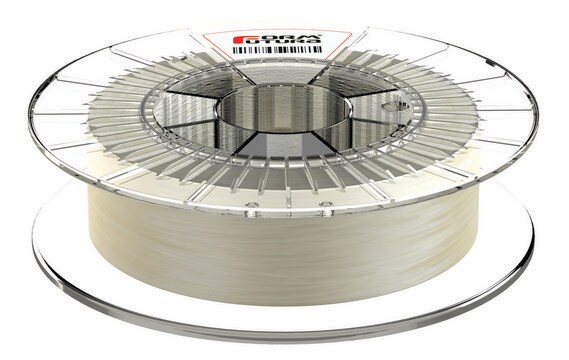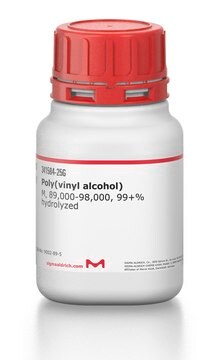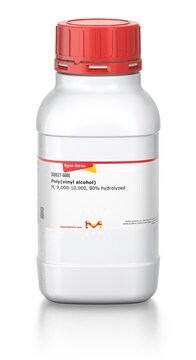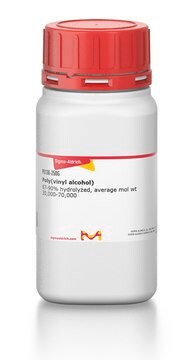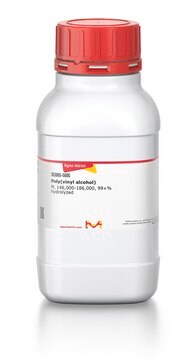推薦產品
品質等級
描述
Filament roundness: ≥95%
Melt flow rate: 2.3 g/10 min
Melt temperature: ±163 °C
Print temperature: ±180-205 °C
Specific gravity: 1.22 g/cc
Spool Hub Diameter: 52 mm
Spool Size (DxH): 200 mmx55 mm
Vicat softening temperature: ± 60.2 °C
形狀
solid (filament)
顏色
orange, natural
直徑
1.75 mm±0.05 mm (filament diameter)
InChI
1S/C2H4O/c1-2-3/h2-3H,1H2
InChI 密鑰
IMROMDMJAWUWLK-UHFFFAOYSA-N
尋找類似的產品? 前往 產品比較指南
一般說明
聚乙烯醇(PVA)混合打印长丝是用于复杂结构的多挤压3D打印的水溶性支撑材料。该材料是不同等级PVA的混合物,可改善聚乙烯醇的热稳定性和可印刷性。除了这些改进之外,这种共混物对湿气降解的敏感性较低,同时又保持其水溶性。这种浅橙色、无味且高质量的长丝可在180至205°C的温度下挤出,适用于所有基于RepRap技术的台式3D打印机,例如MakerBot、Ultimaker、RepRap(Mendel、Huxley、Prusa)、UP、Solidoodle、Leapfrog等。这种PVA混合长丝对多种材料(如PLA、ABS、PETG、ASA、HIPS和尼龙)具有良好的黏附性,并且在水中可生物降解,不会产生有害的副产物。尽管PVA可溶于冷水,但使用连续加热的温水浴可以加速溶解过程。在不使用时,应将长丝储存于室温下干燥处,如密封在塑料袋中或装有干燥剂的密闭容器中。关于推荐的初始打印机设置,参阅“常规打印设置”文件。
應用
AtlasSupport™是Formfutura VOF公司的商标
由于其水溶性和生物相容性,聚乙烯醇(PVA)长丝最常被用作形成具有独特和复杂结构的组织工程构造的牺牲材料。利用这种材料,可以打印具有大凸头、深内腔和/或复杂几何形状的支架。除了用作牺牲材料外,PVA长丝还被用于打印新型口服药物递送装置和片剂。
法律資訊
AtlasSupport is a trademark of Formfutura VOF
儲存類別代碼
11 - Combustible Solids
水污染物質分類(WGK)
WGK 1
閃點(°F)
49.5 °F - closed cup
閃點(°C)
9.7 °C - closed cup
客戶也查看了
Alice Melocchi et al.
International journal of pharmaceutics, 509(1-2), 255-263 (2016-05-25)
Fused deposition modeling (FDM) is a 3D printing technique based on the deposition of successive layers of thermoplastic materials following their softening/melting. Such a technique holds huge potential for the manufacturing of pharmaceutical products and is currently under extensive investigation.
Shuai Li et al.
ACS applied materials & interfaces, 8(38), 25096-25103 (2016-09-09)
Despite considerable advances in tissue engineering over the past two decades, solutions to some crucial problems remain elusive. Vascularization is one of the most important factors that greatly influence the function of scaffolds. Many research studies have focused on the
R Hernández-Córdova et al.
Journal of biomedical materials research. Part A, 104(8), 1912-1921 (2016-03-19)
Biomaterial scaffolds are a key part of cardiac tissue engineering therapies. The group has recently synthesized a novel polycaprolactone based polyurethane-urea copolymer that showed improved mechanical properties compared with its previously published counterparts. The aim of this study was to
Tatsuaki Tagami et al.
Biological & pharmaceutical bulletin, 40(3), 357-364 (2017-03-03)
Three-dimensional (3D) printers have been applied in many fields, including engineering and the medical sciences. In the pharmaceutical field, approval of the first 3D-printed tablet by the U.S. Food and Drug Administration in 2015 has attracted interest in the manufacture
Soumyaranjan Mohanty et al.
Materials science & engineering. C, Materials for biological applications, 55, 569-578 (2015-06-29)
One of the major challenges in producing large scale engineered tissue is the lack of ability to create large highly perfused scaffolds in which cells can grow at a high cell density and viability. Here, we explore 3D printed polyvinyl
我們的科學家團隊在所有研究領域都有豐富的經驗,包括生命科學、材料科學、化學合成、色譜、分析等.
聯絡技術服務